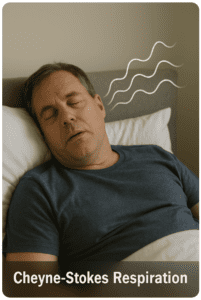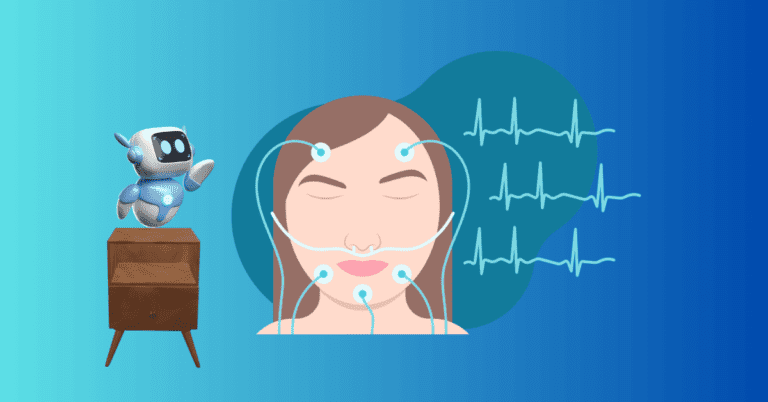Cheyne-Stokes Respiration: The Link to Sleep Apnea
Jeremy Smith is a long-term CPAP user and sleep apnea advocate. After being diagnosed with severe obstructive sleep apnea, he created ByJeremySmith.com to help others navigate CPAP therapy through personal stories, gear reviews, and practical advice.
Cheyne-Stokes respiration (CSR) is an abnormal breathing pattern characterized by periods of deep, rapid breathing (hyperventilation) followed by slow, shallow breathing or even temporary pauses in breathing (apnea).

This distinctive breathing pattern is often associated with heart failure, stroke, or neurological disorders, and it can be particularly disruptive during sleep.
In this article, we’ll explore Cheyne-Stokes respiration, how it affects sleep, and its connection to sleep apnea.
What Is Cheyne-Stokes Respiration?
Cheyne-Stokes respiration is a type of central sleep apnea that occurs when the brain temporarily fails to regulate breathing patterns.
This results in a cycle of hyperventilation followed by hypoventilation or periods of apnea, creating a waxing and waning pattern of breathlessness. During a CSR episode, a person’s breathing gradually increases in depth and rate, then slows down, eventually leading to a pause in breathing.
The name “Cheyne-Stokes” comes from the two physicians—John Cheyne and William Stokes—who first described the condition in the 19th century.
While CSR can occur during both wakefulness and sleep, it is most often observed during sleep, particularly in people with underlying heart conditions or neurological disorders.
What Causes CSR?
CSR is typically caused by heart failure or neurological conditions. In these cases, the brain’s respiratory control centers in the brainstem become less responsive to changes in carbon dioxide (CO2) levels in the blood, leading to the irregular breathing patterns seen in CSR.
1. Heart Failure
One of the most common causes of Cheyne-Stokes respiration is heart failure. In heart failure, the heart’s ability to pump blood is reduced, leading to poor circulation and low oxygen levels. This can trigger the brain to overcompensate by initiating periods of rapid breathing followed by slow or paused breathing.
2. Stroke or Brain Injury
In some cases, CSR can result from damage to the brainstem due to a stroke, traumatic brain injury, or other neurological conditions. The brainstem plays a crucial role in regulating breathing, and any disruption to this area can lead to irregular patterns like CSR.
3. Central Sleep Apnea
CSR is often categorized as a form of central sleep apnea (CSA). In CSA, the brain intermittently fails to send the proper signals to the muscles responsible for breathing, resulting in pauses during sleep. Cheyne-Stokes respiration is a specific type of CSA with its characteristic cyclical pattern of deep and shallow breaths.
Symptoms
The primary symptom of CSR is an abnormal breathing pattern. However, the consequences of these irregularities can extend beyond breathing difficulties and significantly impact a person’s overall health, particularly during sleep.
Common symptoms of CSR include:
- Periods of hyperventilation followed by apnea (breathing pauses).
- Snoring or gasping for air during sleep.
- Frequent awakenings during the night due to interrupted breathing.
- Daytime fatigue or excessive sleepiness, as CSR disrupts the normal sleep cycle.
- Morning headaches and difficulty concentrating.
If left untreated, Cheyne-Stokes respiration can increase the risk of complications, especially in people with heart failure or neurological disorders.
The disruption in oxygen levels during sleep can exacerbate cardiovascular issues and contribute to poor overall health.
How Cheyne-Stokes Respiration Affects Sleep Apnea
Cheyne-Stokes respiration is closely related to central sleep apnea (CSA), and many patients with CSR also experience CSA.
The key difference between obstructive sleep apnea (OSA) and CSA is the cause of the breathing disruption. In OSA, the airway becomes physically blocked, while in CSA, the brain fails to send the necessary signals to maintain regular breathing.
In CSR, the brain’s control of breathing becomes erratic, leading to alternating periods of fast and slow breaths, often resulting in pauses (apneas).
This irregular breathing pattern can severely disrupt the sleep cycle, causing frequent awakenings and preventing the body from entering deep, restorative sleep stages.
People with heart failure, in particular, are at an increased risk of developing both CSR and central sleep apnea, as the compromised heart function can further exacerbate irregular breathing patterns.
Diagnosis
Diagnosing CSR typically involves a polysomnography, or sleep study, to monitor breathing patterns during sleep.
Polysomnography records various physiological parameters, such as airflow, blood oxygen levels, heart rate, and brain activity, helping doctors identify the characteristic waxing and waning breathing patterns of CSR.
Additionally, doctors may perform an echocardiogram to assess heart function, as Cheyne-Stokes respiration is closely linked to heart failure. Identifying the root cause of CSR is critical for developing an effective treatment plan.
Treatment for Cheyne-Stokes Respiration
Treatment for Cheyne-Stokes respiration focuses on managing the underlying condition—whether it’s heart failure or a neurological disorder—and stabilizing breathing patterns. Several options are available to help reduce the severity of CSR and improve sleep quality.
1. Continuous Positive Airway Pressure (CPAP)
For some patients, a CPAP machine may provide a steady stream of air pressure, preventing apneas and promoting regular breathing. CPAP is commonly used for treating obstructive sleep apnea but can also be effective for some patients with central sleep apnea or CSR.
2. Adaptive Servo-Ventilation (ASV)
ASV machines are often recommended for patients with CSR, particularly those with central sleep apnea. ASV therapy provides adaptive pressure, automatically adjusting the air pressure based on the patient’s breathing patterns to maintain a regular respiratory rhythm. This helps stabilize breathing and prevent apneas during sleep.
3. Heart Failure Management
Since heart failure is a major contributor to Cheyne-Stokes respiration, managing heart health is essential. Medications such as diuretics, ACE inhibitors, or beta-blockers can help improve heart function and reduce symptoms of CSR.
In severe cases, surgical interventions such as the implantation of a ventricular assist device (VAD) or heart transplant may be necessary.
4. Oxygen Therapy
In some cases, supplemental oxygen may be prescribed to help stabilize oxygen levels during sleep. This can reduce the severity of CSR and improve overall sleep quality.
Conclusion: Living with Cheyne-Stokes Respiration
Cheyne-Stokes respiration can be a challenging condition to manage, especially when it occurs alongside other health issues like heart failure or neurological disorders.
However, with proper diagnosis and treatment, patients can experience significant improvements in their sleep quality and overall health.
Suppose you or a loved one is experiencing symptoms of Cheyne-Stokes respiration, such as irregular breathing during sleep or daytime fatigue. In that case, it’s essential to consult a healthcare provider for an evaluation.
Early intervention can help manage the condition and prevent further complications.
Disclaimer: The content on this blog is for informational and educational purposes only and is not a substitute for professional medical advice. Always speak with your doctor or sleep specialist before starting, stopping, or changing any treatment or therapy related to sleep apnea or CPAP use.





